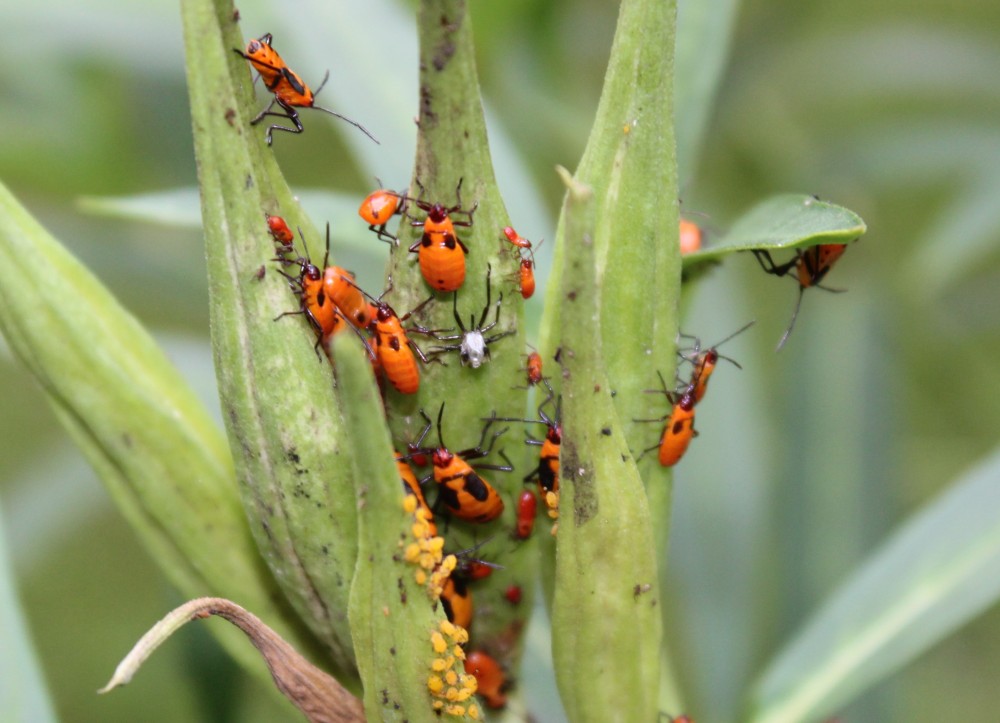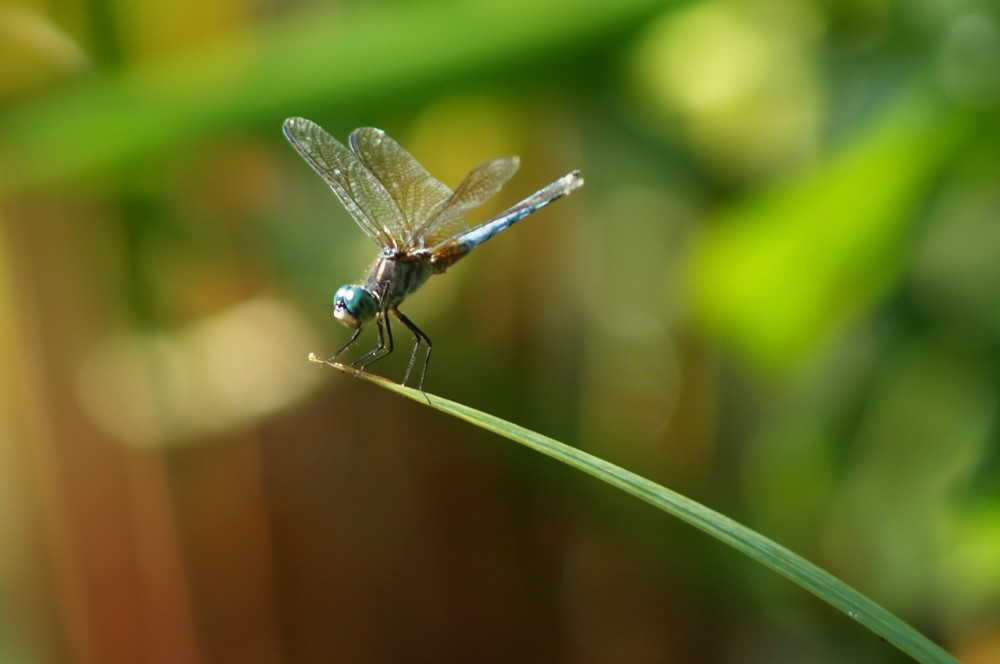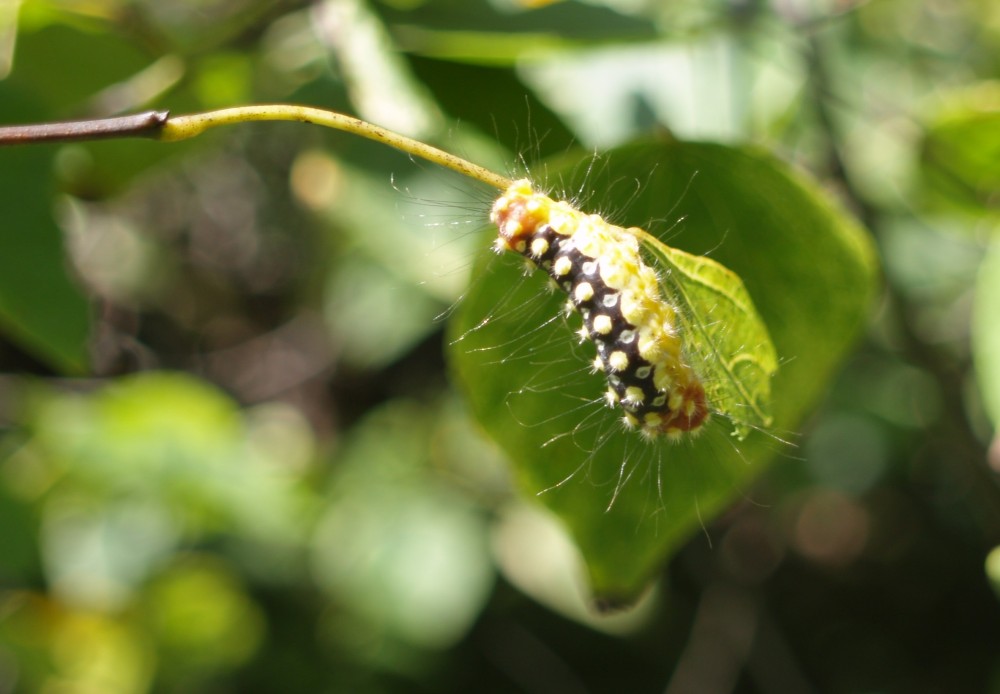I was unconcerned when I first noticed an infestation of aphids on seedpods of the Swamp milkweed (Asclepias incarnata, below). What harm could be done to this vigorous native? Probably none, and I planned to let nature takes its course.
Its course, as it turns out, was to attract beetles that have quickly stripped aphids from several sets of seedpods. I expect all aphids will be gone in another few days without intervention on my part. Given the few disease and pest problems in this garden, I suspect that natural controls occur many more times than I’m able to witness.
Certainly, I notice dragonflies darting across the koi pond, and with the notable lack of Tiger mosquitoes in the vicinity, I suspect dragonflies are the reason. While much of the zipping about of the dragonfly defines its territory, other movements are predatory, though the violence of the capture of the mosquito occurs at a speed that I cannot see.
This afternoon, I noticed the start of webworms in the Silver Cloud redbuds (Cercis canadensis ‘Silver Cloud’, below). To the best of my recall, the stinging caterpillar of the White Flannel moth did not infest the redbuds last summer, but a year earlier a significant portion of the trees was defoliated in late summer.
At the time, I was unaware that the caterpillars were one of the stinging types until I stooped to pull a weed beneath a redbud’s arching branches. A few were dislodged from leaves onto my bare arm, and with the stinging parts facing up I was stung only when I flicked them off with my hand. This is not the first time I’ve been stung by caterpillars, and as I poke my nose too close, too often, it will certainly not be the last. The sting is painful enough that you will pay closer attention the next time.
I am interested to see if this webworm will be the same, but possibly it will be another caterpillar. In any case, I expect no long term damage to the redbuds. Though I do not spray pesticides, when I happen to notice an infestation I will closely watch it from start to finish. I read that a large portion of a bird’s diet is caterpillars, but I have yet to see it, and it seems this will not be a solution for the caterpillars. If the infestation becomes too severe, I can take action, but I don’t recall ever needing to do anything. 
Several years ago, one of two weeping Golden Chain trees (Laburnum x watereri ‘Pendulum’, above) was infested with another stinging caterpillar. I watched over a week as the small tree was completely defoliated. I thought that I might have let this go too far, but the following spring there was no obvious loss of vigor, and with this experience I am curious to follow the progress of this year’s webworms.
Hi Dave, the orange beetles in the first photo look like juvenile-stage large milkweed beetles (Oncopeltus fasciatus), which (like aphids) like to feed on milkweed seeds. If that’s right then they may be compounding your problem rather than solving it! Still, at least in my garden milkweeds seem to take such things in stride and rarely look worse for the wear.
I’m certain that you’re correct about the beetles. I’ll be interested to see what happens.
THIS IS the second year my before prized milkweed is totally infested with these dreadful bugs and again no monarch caterpillars .a neighbor wondered if these insects eat the caterpillar eggs.Also I am greatly disappointed at it being the first year without black swallowtail caterpillars on my dill,parsley and fennel. I do not believe in toxic sprays ,but talking every bug on my milkweed is not doable
I cannot hope to understand the complexities of nature. As a gardener I set the stage by planting, then observe. One year there are abundant numbers of swallowtails, and inexplicably, the next very few. My attempts to understand natural cycles are fruitless, but still fascinating.
PLEASE! Tell me what you do about leaves in the fall on your pond! How many skimmers for how many gallons?
Each of the ponds in the garden has a skimmer, but with overhanging trees I must cover ponds with nets in autumn. Skimmers are effective for leaves that drop in spells of dry weather, but mostly skimmers keep the pump from fouling constantly.Long ago, when pumps were routinely placed on the bottom of the pond, it was necessary to clean filters a few times each week. Now, this is done every few months.
The koi pond is about 1400 square feet, and though trees do not directly overhang, leaves from tall maples and tulip poplars would drift to quickly fill the pond if it was not covered with a net. Since this pond contains about 20,000 gallons I will never empty it for cleaning, so the net goes on when leaves begin to fall.